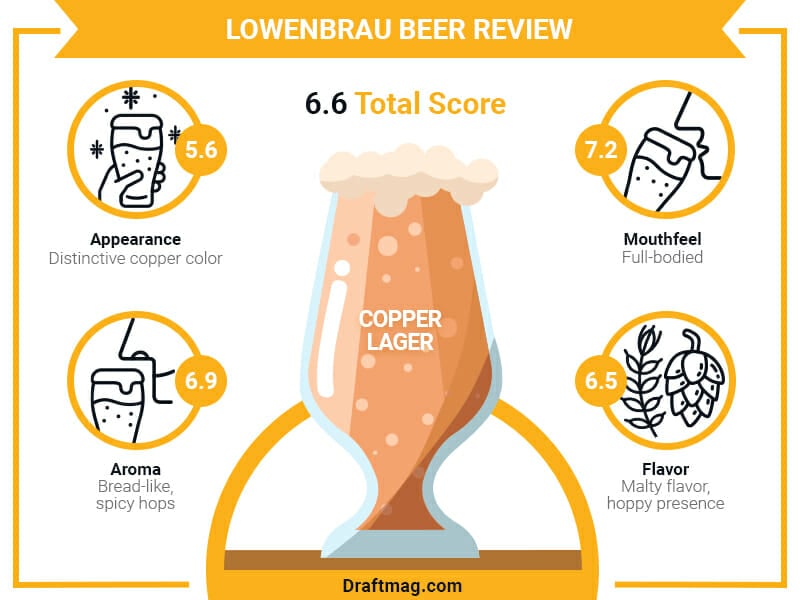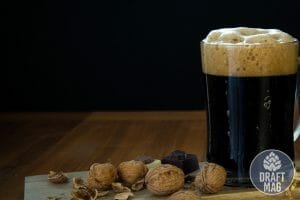Lowenbrau Beer Review: Everything About This Superior German Lager
Lowenbrau beer might be called the ideal lager for many, and we can’t blame them. The beer that is brewed exclusively in its Munich brewery has managed to capture the attention of beer lovers all over the world.

From beer beginners to avid enthusiasts, everyone has been raving about this special beer that is one of only six available brands served during the popular Oktoberfest celebration. In this complete review, our experts will unfold exactly what makes a Lowenbrau special and why it deserves your attention.
Lowenbrau Beer Stats
| Country | Germany |
| Brand | Lowenbrau |
| Style | Copper Lager |
| Taste | Sweeter, less hoppy |
| Body | Full bodied |
| ABV | 5.8 percent alcohol content |
| Flavors and Aromas | Malty, slightly sweet tinge |
| Serving Temperature | 45-50 degrees Fahrenheit |
Tasting Notes
Lowenbrau Beer Review
With a name that directly translates to “Lion’s Brew,” Lowenbrau beer definitely has big shoes to fill. Fortunately, the unique Munich brew does not disappoint. From its rich, golden appearance to its malty and sweet taste and aroma, this beer tops the list of numerous enthusiasts.
Being one of only six brands available to be served during Oktoberfest is a testament to how this brew has kept its excellent quality and impeccable reputation throughout the years. Without further ado, here is everything you need to know about Lowenbrau original beer:
– Appearance
The moment this premium German lager fills up a stein in front of you, it is instantly recognizable by its distinctive copper color. This good beer gets its remarkable color due to the special cooking process of the malt.
The golden color of this brew is a good precursor of the excellent taste and aroma of the beer when you finally take a sip. There are several streams of bubbles continuously moving throughout the beer, while its thin foam head is persistent.
– Aroma
Once you get past the strange yet alluring appearance of the Lowenbrau, a slightly different bread-like aroma hits your nose, followed by strong notes of spicy hops. Overall, this beer will remind you of a Pilsner through its aroma.
The smell of grains is dominantly observed upon the first sniff, and it is followed by what can only be described as a bit of a skunky smell. However, don’t let the initial smell put you off this beer.
– Mouthfeel
And now it’s time to sip the beer. The moment it goes inside your mouth for the first time, you get the moderately full-bodied mouthfeel with the soft carbonation taking over your palate.
It has a light to medium mouthfeel and a bit of dryness as you go through the beer. It is a very smooth brew with a soft carbonation, making it an easy drink for a lazy day or when hanging out with friends and family.
– Flavor
In short, the beer is malty with a moderately full body. The large malty flavor of the Lowenbrau beer is punctuated by a consistent hoppy presence. A wholesome aftertaste combines well with the buttery aroma. And finally, you feel the sticky sweetness characteristic of Lowenbrau Märzens, with only a little bit of dryness.
There is a touch of sweetness from the apple flavor permeating throughout the intense maltiness of the brew. Aside from that, the grainy notes are also prominent as you continue to sip the delectable beverage.
– Food Pairings
A strong German beer goes well with typical German and central European fare. The two main recommended food groups include:
- German food: Grilled chicken and pork sausages pair extremely well with the sticky sweetness and warm and toasty bread notes of the Lowenbrau. You can also drink the beer along with some smoked pork chops while lazing around at home. Quite surprisingly, it also adds an element of edge to pizza. Do not be afraid to try different toppings with a stein of Lowenbrau.
- Cheese: What beer does not go well with cheese? Lowenbrau does too, and excellently at that. The malty and bready flavor that we have talked about cuts right through salty cheese for a match made in heaven. Special alpine cheese varieties like Comté, Fontina, and Gruyère and richly flavored ones like Gouda also make a splendid pairing with the peppery hops of the Lowenbrau.
In short, there are a plethora of food items that work smoothly with the beer. Just gather around your friends and cook up something that goes well, and you’re definitely locked in for a good time.
Lowenbrau Ingredients
Lowenbrau is brewed in strict compliance with the “Reinheitsgebot,” or the ancient German law of purity. According to the Reinheitsgebot, only four ingredients: water, yeast, hops, and barley malt are allowed to be used to brew any pure German beer. The different German beer types, thus, only differ in their techniques and casking processes.
Let’s look at the four ingredients in detail below:
– Water
Like everything else, water makes up the bulk of beer as well, almost 90 to 95 percent of it. This effectively outlines the importance of water for any brew, and it’s the same case with Lowenbrau. There are three main things to keep in mind in terms of its influence on the Lowenbrau brewing process.
The water must be in pristine condition. That’s the very first rule. Chlorine or any other type of contaminant in the water can throw the entire taste of the beer off.
The pH level of water affects the perceived bitter taste of the beer and needs to be controlled.
During the brewing process, the liquid extracted from the mash is called the “wort.” The flavor of the wort entirely depends on the water’s characteristics.
The age-old brewing process at Lowenbrau uses the best quality water devoid of any contaminants or elements that can offset the natural flavor of the local water. They are well versed in the processes of adjusting water to make their brew taste exceptional.
– Yeast
Yeast, the single-cell organism, has been the key to the brewing process since time immemorial. Yeast is responsible for eating up certain sugars such as Dextrin, Maltotriose, Sucrose, Fructose, Glucose, and Maltose and orchestrates the process of fermentation that produces the alcohol necessary for brewing beer. Besides alcohol, several fermentation by-products, including carbon dioxide, are also formed at the end of the process.
To brew Lowenbrau lager, Saccharomyces pastorianus, or a specific lager yeast is used. It is a bottom-fermenting yeast that typically ferments colder as compared to the ale, with fermentation temperatures ranging from around 40 to 50 degrees Fahrenheit. Due to the cold fermentation process, the fermentation compounds are much lower.
The yeast is also responsible for the characteristic clear, crisp, and clean appearance of the Lowenbrau as they absorb up any flavors derived by fermentation in a post-fermentation conditioning process called lagering.
– Hops
Hops, or for the context of beer brewing, the conical flowers of the female hops plant Humulus lupulus, are one of the key components of beer. The oils and acids inside the hop flowers are responsible for the stability, flavor, and, most importantly, the bitterness of the finished beer.
During the fermenting process, hops release bitter components that balance the sweetness of the malt. However, it takes significantly longer to release them, needing as much as an hour at times. Due to this, the hops are added in the boiling stage of fermentation. As Lowenbrau lagers are only slightly hoppy, the hops aren’t generally added later other than the boiling stage.
However, in other cases, hops may be added later to bolster the hoppy flavor of the beer. The flavor and body of the beer can be greatly influenced depending on the stage at which hops are added to the brew. Another point of note is the IBU level, or the International Bittering Units level, which helps determine the bitterness compounds of a Lowenbrau beer.
– Barley Malt
The cereal Barley must undergo the malting process before it can be used in brewing. Malting helps moisten up the grain, which helps its natural process of germination. Barley’s role in brewing Lowenbrau can be equated to the grape’s contribution towards winemaking, i.e., essential.
Malted barley is instrumental in providing the natural sugars for fermentation, protein for a robust head, and dextrins that help form the unique body of the Lowenbrau. Different malt types influence the taste and color of the beer and Lowenbrau have its unique variety of barley that ensures consistency.
Lowenbrau Nutrition Facts
It is estimated that a serving of 500 milliliters of original Lowenbrau Marzen lager contains:
- Calories: 225
- Carbs: 16 grams
- Fat: 0 gram
- Protein: 1 gram
Take note that the Lowenbrau beer is not keto-friendly because of the high amount of net carbs it contains. It has an alcohol by volume amount of 5.2 percent, which is pretty standard for lagers like Lowenbrau. For those who are light drinkers, a can or two would definitely lead to tipsiness or even drunkenness. Make sure to drink moderately!
History
The Lowenbrau Brewery combined with another brewery at 17 Löwengrube, which reportedly finds its origins in the late 1300s. The brewery was purchased by a peasant in the early 1800s and their combined effort moved to a new location on the Nymphenburger Strasse in 1851. By 1863, Lowenbrau, now fortified with additional production capabilities, evolved into the largest brewery in Munich, producing almost 25 percent of the entire quantity of beer being produced in the city.
Under the 1872 incorporated name of Aktienbrauerei Zum Löwenbräu, the brewery was able to add on several surrounding properties. The Löwenbräukeller was subsequently built-in 1882. On June 14th, 1883, the new and expanded property was launched in a grand ceremony under the tutelage of architect Alber Schmidt and the Rank Brothers, its builders.
The now-iconic lion logo was trademarked officially in 1886, announcing the emergence of Lowenbrau as the largest brewery not just within the city but within the borders of the entire Bundesland.
– Pre-modern History
Much later, in 1921, a large, Munich-based beer hall Bürgerbräukeller was acquired by Lowenbrau. At this point, a certain Joseph Schülein ended up as the sole owner of this large brewery, which led to the moniker “Jewsbeer” for Lowenbrau. The industrial revolution led to an explosion in the popularity of an already popular beverage and Lowenbrau started registering major sales figures hitherto unseen.
The spiraling demand for beer was indeed good news for Lowenbrau and led to advancements in bottle blowing and filling techniques with the advent of automation to counter the demand-supply offset.
– Lowenbrau Today
The ancient brewing house has gone through the initial stages of its product lifecycle, including development and growth. And today, the product lifecycle of Lowenbrau is at the maturity stage. If the North American market is examined, it may be closer to the decline stage.
This is because North American consumers are starting to prefer more domestic, locally brewed beers like Molson Canadian, Sleeman, and Alexander Keith’s. Many foreign beer brands, including Lowenbrau, are, therefore, seeing a sharp decline in terms of overall sales as well as advertising compared to their European market.
FAQs
– Is Lowenbrau Beer Still Being Brewed?
Yes, Lowenbrau beer is still being brewed to this day. However, the biggest trump for Lowenbrau as a brand lies much closer to their home. Lowenbrau is one of the six Munich-based beer houses that can be sold at Oktoberfest along with other brands such as Staatliches Hofbräu-München, Spatenbräu, Paulaner, Hacker-Pschorr-Bräu, and Augustiner-Bräu.
The Oktoberfest is the world’s largest and best-known beer festival, with attendance running in several million every year. The Oktoberfest diktat mentions that only the beers brewed within the city limits and adhere to the ancient German purity laws – Reinheitsgebot — can be sold and served at the event.
Lowenbrau has garnered vast popularity as it has been served at Oktoberfest every year since 1810. Being one of the only six brands available makes the competition quite tough, but with its distinctive style and taste, Lowenbrau keeps chugging on as millions throng its stalls for a chance to gulp down steins of this magical copper brew. And even though its popularity has waned considerably, it is still a stand-up brew denoting finesse, purity, and an untamed passion for the art of brewing.
– Who Owns Lowenbrau Beer?
Lowenbrau beer is owned and brewed by Lowenbrau Brewery. The history of Lowenbrau – Lion beer in German — is long and winded, but a fascinating one, nonetheless. The beer and its vaulted brewery have passed the annals of both German as well as European history.
The Lowenbrau Brewery was established in 1690 in Munich, Bavaria and is generally renowned for being one out of six breweries that represent local beers at the Oktoberfest. This is because Oktoberfest only features beers that are brewed locally within the city limits.
– Is Lowenbrau Beer Available in the United States?
Yes, Lowenbrau beer is available in the United States. The year 1975 marked a watershed moment in the history of Lowenbrau when Miller Brewing, the American company, purchased the rights to brew and distribute Lowenbrau across North America. Initially, they started by importing beer directly from Munich for two years, after which an Americanized recipe was unfurled to allow for products directly on their soil.
The introduction of Lowenbrau in America served a greater purpose for Miller as they wanted to go head-on with the Michelob brand of Anheuser-Busch. The Labatt Brewing Company held exclusive brewing rights to Lowenbrau from 1999 to 2002. After that, the original Munich version of Lowenbrau kept being exported to America.
The original German brewery had merged with Spaten-Franziskaner-Bräu in 1997 to become the Spaten-Löwenbräu-Gruppe conglomerate. Lowenbrau was sold to Interbrew in 2003, which, in turn, merged with AmBev to become InBev in 2004. In 2005, further mergers happened, now between one of their largest competitors, Anheuser- Busch to ultimately form the Anheuser-Busch InBev group. In 2014, however, Labatt Brewing company regained its rights to brew Lowenbrau in North America and restarted production at its new facility in London, Ontario.
Conclusion
If you are fond of the classics, then the Lowenbrau is the brew for you. The beer, which has formed a part of folklore for centuries, is widely consumed and enjoyed by beer connoisseurs across the length and breadth of the planet, so to summarize, here are the most important points we discussed in the complete guide above:
- Lowenbrau is a copper-colored lager originating from its brewery in Munich, Germany.
- The beer is made following Reinheitsgebot, the ancient German purity law that allows only four ingredients for manufacturing beer.
- Lowenbrau has a spicy and bread-like aroma with a smooth, hoppy flavor and pairs well with most German meat and cheese-based fare.
- The original Lowenbrau brewery was established in Munich in 1690.
- It is one of the six original Munich-based brews that is served during Oktoberfest.
If you want to taste a slice of beer history, Oktoberfest is perhaps your best bet, or you can also visit your local liquor store to inquire about their availability and Lowenbrau beer price. Through centuries, civilizations, and wars, Lowenbrau has managed to stay alive and kicking to tickle our taste buds even today.






